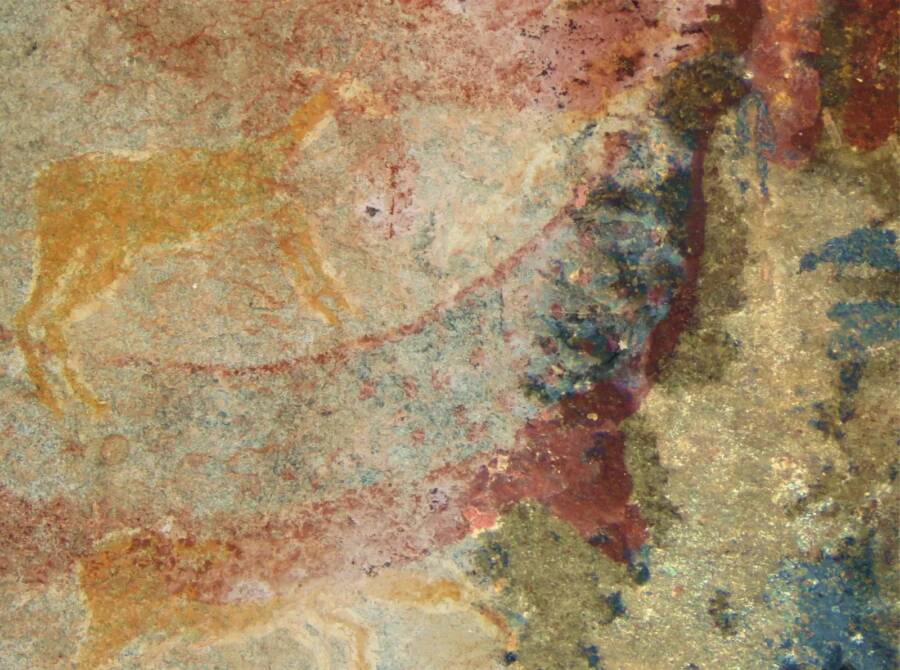19th-Century South African Rock Art May Depict A Long-Extinct Horned Serpent
Julien BenoitThe rock art that may portray a dicynodont.A nearly 200-year-old rock painting, long a source of mystery in the mountains of South Africa, may depict a creature that vanished from the Earth more than 200 million years ago, according to new research. The finding suggests that the Indigenous San people were essentially the worlds first paleontologists, discovering and interpreting fossils long before the formal establishment of the scientific field.The Horned Serpent Panel May Depict A Prehistoric CreatureThe artwork, part of a larger mural known as the Horned Serpent panel, is located at the La Belle France heritage site in South Africas Free State province. Painted between 1821 and 1835, the panel features scenes of human figures and other recognizable animals. However, one creature stands out: a long-bodied, polka-dotted beast with strange, downward-curving tusks, unlike any species known to have lived in the region during recorded history.Julien BenoitVarious paintings on the Horned Serpent panel.For years, the identity of this creature has puzzled researchers. Now, a study published in the journal PLOS ONE by paleontologist Julien Benoit from the University of the Witwatersrand in Johannesburg proposes a compelling theory. Benoit argues the painting is likely a representation of a dicynodont, a tusked herbivore that was abundant in the area during the Permian and Triassic periods.This work supports that the first inhabitants of southern Africa, the San hunter-gatherers, discovered fossils, interpreted them and integrated them in their rock art and belief system, Benoit stated in a press release accompanying the study.The Karoo Basin, where the rock art is located, is a world-renowned hot spot for fossils, particularly those of dicynodonts. These prehistoric herbivores, which predate many dinosaurs, often had beaked mouths and prominent tusks. Erosion in the region frequently exposes their well-preserved skeletons, making their fossils relatively easy to find.Julien BenoitThe artwork compared to a dicynodont fossil.Benoits hypothesis rests on several key pieces of evidence the most significant of which is the orientation of the creatures tusks. While animals like warthogs have upward-curving tusks, the painting clearly shows them pointing downwards, a feature consistent with many dicynodont skulls found in the Karoo. Furthermore, San oral traditions include stories of enormous brutes that once roamed the land and are now extinct.Pure imagination may be safely ruled out as the San did not paint things that were completely imaginary, Benoit explained to Newsweek. Their art was based on real-life elements, mostly animals.If Benoits interpretation is correct, the San people identified an extinct animal and recorded their findings at least a decade before the first dicynodont was formally described by British scientist Sir Richard Owen in 1845. This reframes the history of paleontology, placing its origins not in 19th-century Europe, but in the observations of southern Africas earliest inhabitants.The ethnographic, archaeological, and paleontological evidence are consistent with the hypothesis that the Horned Serpent panel could possibly depict a dicynodont, Benoit wrote in the study. Potential Spiritual Connections In San Rock ArtThe painting may have also held deep spiritual significance for its creators. The creature could be a representation of a rain-animal, a powerful being in San culture associated with bringing rain. Benoit suggested that by depicting a creature they knew to be extinct, the artists may have believed it held greater spiritual potency, capable of bridging the worlds of the living and the dead. Viliam Simko/Wikimedia CommonsA life-sized model of a dicynodont at the Museum fr Naturkunde Karlsruhe in Germany.This spiritual interpretation does not conflict with the paleontological one, either. Rather, it further emphasizes how scientific observation was woven into the cultural and religious fabric of San life.The relevance of the discovery is twofold: first, for the history of science, as the San would have found dicynodonts before Western scientists did. This brings a new perspective to the history of sciences and how we conceive discoveries,' Benoit said.Secondly, it is cultural, Benoit continued, as the San would have integrated fossils into their belief system, which may shed some light on other mysterious rock art that have eluded explanation so far.After learning about the connection between this 200-year-old rock art and the prehistoric dicynodont, read about another legendary creature from South Africa: the Grootslang. Then, go inside the legend of the basilisk, a rooster-serpent hybrid that could kill with a single look. The post 19th-Century South African Rock Art May Depict A Long-Extinct Horned Serpent appeared first on All That's Interesting.


